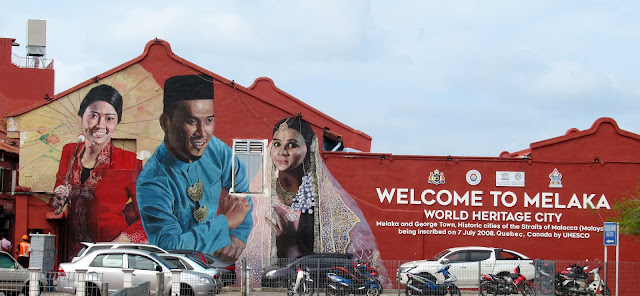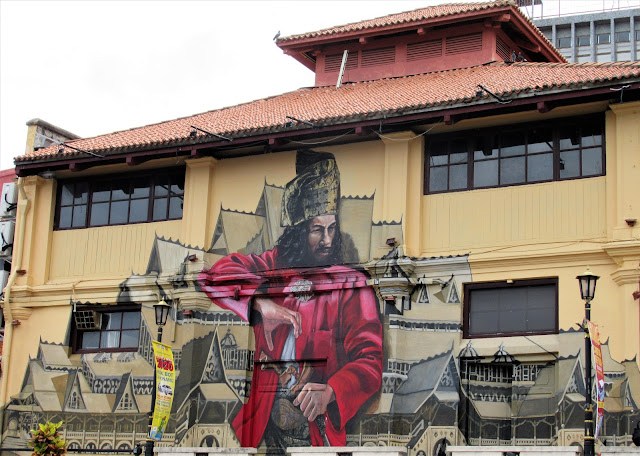We are charmed by Melaka as soon as we set foot on her historic riverfront. Early on we do a riverboat tour on the Melaka River.
 |
| On a bigger section than this, they have left some natural mangrove |
Riverside buildings with painted faces reveal her many ethnicities:
Pretty bridges weave you back and forth to savor all her nooks and crannies
Shimmering lights, like jewels, heighten her nighttime beauty.
In the Downtown Core:
A Famosa
Here's what Wikipedia says about the remains of this fort:
Stadthuys
In the heart of Melaka, built in 1650, this is the oldest remaining Dutch historical building in the Orient. It's known as red square for the colour of the building and the clock tower ... and I daresay the paving stones in the street. Its a lively place and its where to go if you need a tri-shaw, some souvenirs or to mail a postcard.
Melaka Sultinate Palace Museum
This museum at the foot of St. Paul's Hill which was the administrative centre of Melaka is an exact replica of a palace built in 1459 before the Portuguese came to rule the city. The Shah's palace was the most elaborate royal palace in the world at that time, a pity it was destroyed by lightning. This huge wood palace is built without one nail. There are the usual collections that you might expect of weaponry, art, costumes, jewelry, and cookware, but I found the most interesting to be the dioramas of famous legends of the time. The history told in this museum is the Malay side of Melaka's story. This museum is definitely worth a visit and a stroll through the gardens when you're finished inside.
Melaka was a trading port. These dioramas show traders from different countries.
Jonker Street
A visit to the open-air Jonker Walk Market in Chinatown is full of history, culture, shopping, and just plain fun in the daytime. It's even better on Friday or Saturday when it's open late for the night market. A few antique stores remain from the old days, places of worship such as the Cheng Hoon Teng Temple, the Kampung Kleng Mosque, the Sri Poyyatha Vinayagar Hindu Temple, and the Masjid Kampung Hulu mosque built in 1728. The beautiful Jonker Street Library full of Chinese furniture is worth a look. There are lots of clothing (including some vintage fashion) stores, crafts, souvenirs, eateries, bars, and even some entertainment. Here too is the Baba-Nyonya Museum and the Cheng Ho Cultural Museum.
A Famosa
Here's what Wikipedia says about the remains of this fort:
"A Famosa is a former Portuguese fortress located in Malacca, Malaysia. It is among the oldest surviving European architectural remains in Southeast Asia and the Far East. The Porta de Santiago, a small gate house, is the only part of the fortress which still remains today"
Stadthuys
In the heart of Melaka, built in 1650, this is the oldest remaining Dutch historical building in the Orient. It's known as red square for the colour of the building and the clock tower ... and I daresay the paving stones in the street. Its a lively place and its where to go if you need a tri-shaw, some souvenirs or to mail a postcard.
 |
| Photo Credit: Wikipedia |
This museum at the foot of St. Paul's Hill which was the administrative centre of Melaka is an exact replica of a palace built in 1459 before the Portuguese came to rule the city. The Shah's palace was the most elaborate royal palace in the world at that time, a pity it was destroyed by lightning. This huge wood palace is built without one nail. There are the usual collections that you might expect of weaponry, art, costumes, jewelry, and cookware, but I found the most interesting to be the dioramas of famous legends of the time. The history told in this museum is the Malay side of Melaka's story. This museum is definitely worth a visit and a stroll through the gardens when you're finished inside.
Melaka was a trading port. These dioramas show traders from different countries.
 |
| Traders from Java |
 |
| Traders from China |
 |
| Traders from the Arab countries |
Jonker Street
A visit to the open-air Jonker Walk Market in Chinatown is full of history, culture, shopping, and just plain fun in the daytime. It's even better on Friday or Saturday when it's open late for the night market. A few antique stores remain from the old days, places of worship such as the Cheng Hoon Teng Temple, the Kampung Kleng Mosque, the Sri Poyyatha Vinayagar Hindu Temple, and the Masjid Kampung Hulu mosque built in 1728. The beautiful Jonker Street Library full of Chinese furniture is worth a look. There are lots of clothing (including some vintage fashion) stores, crafts, souvenirs, eateries, bars, and even some entertainment. Here too is the Baba-Nyonya Museum and the Cheng Ho Cultural Museum.
Below are some of the many snack offerings of the night market. The fried squid looks so yummy but we're trying hard to avoid fried. The drinks on offer mirror the lights along the river.
Durian is everywhere in Malaysia, its fragrance announces its presence a block away and in public buildings and transportation, we see 'no durian' signs. Families and friends gather at durian booths to share a fruit snack. Durian flavours many foodstuffs: ice cream, biscuits, filled chocolates and so much more. We are not yet sophisticated enough to fully enjoy its flavour.
 |
| Wood soles with plastic uppers. Those are wood pegs in the black ones!! |
Kampung Morton
Out walking we stumble upon Kampung Morton, a community of over fifty traditional Malay houses with red zinc rooftops. Many have been turned into riverside guesthouses. If we return, we would opt to stay in a guesthouse here.
The Village is named after the man who helped local people purchase the land (which was then a mangrove swamp) for their village. It's now surrounded by high rise modern buildings.
In the evening as we stroll the river walk back to our hotel from downtown, the families from Kampung Morton are gathered around tables and chairs on the river walk. Eating, laughing, and sharing. A true neighbourhood.
Out walking we stumble upon Kampung Morton, a community of over fifty traditional Malay houses with red zinc rooftops. Many have been turned into riverside guesthouses. If we return, we would opt to stay in a guesthouse here.
The Village is named after the man who helped local people purchase the land (which was then a mangrove swamp) for their village. It's now surrounded by high rise modern buildings.
In the evening as we stroll the river walk back to our hotel from downtown, the families from Kampung Morton are gathered around tables and chairs on the river walk. Eating, laughing, and sharing. A true neighbourhood.
Villa Sentosa is the oldest home in Kampung Morton. It sits on stilts on the bank of the Melaka River. This ancestral family home is open to the public for no charge, but donations for upkeep are appreciated. All five of the discreet but interconnected pavilions around a courtyard are available to visitors. Mr. Ibrahim Hashim (75 years) who lives here, proudly tells stories of the antiques within, of his ancestors' (originally from Indonesia) roles in building the villa and in founding the village and explains how the open-air design of the house around a courtyard keeps it cool and bright. He is a delight to talk to.
Melaka is a lovely city to relax and spend some time in. We may be back. The next stop is Kuala Lumpur for just a couple of days before heading to Borneo. We're looking forward to getting together with new friends Christine and Warren whom we met on Pangkor Island. They lived and worked in KL at one time and have generously offered to show us around. We have rooms booked at the same hotel.
Random Photos Melaka
 |
| Just inside the print museum |
 |
| Tea anyone? |
 |
| Very tiny tiles make up this mosaic |
The tri-shaws in Melaka are the most decorated ever.
Each has music and different riders play their favourite genre.
Each has music and different riders play their favourite genre.
 |
| And of course, they are lit up at night |

























































No comments:
Post a Comment